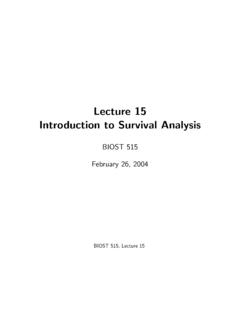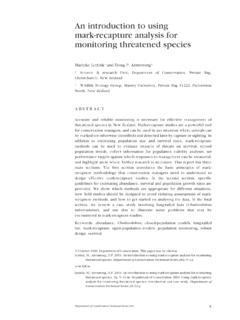Transcription of Survival of the Fittest - Casey Quirk
1 Survival of the Fittest : Defining Future Leaders in Asset Management The operating environment for asset management firms worldwide (outside China) will continue to pose challenges: The industry's annual organic growth will slow to <1% by 2021. Annual revenue growth will fall to from Median profit margins will drop to 28% from 34%. Four catalysts are driving secular industry change, driven by growing demand for outcome- oriented portfolios: New buyer demands emphasizing different value propositions for asset managers Skepticism regarding active management fueling growth for old and new betas Disruptive technologies slashing distribution costs and reinventing the consumer experience Fiduciary-driven regulation reorienting advice delivery and product pricing Nevertheless, one-third of asset managers worldwide are still growing faster than the currently oversupplied marketplace, using any of four competitive advantages to differentiate themselves.
2 Innovative product development Strong, positive brand recognition Distinct customer experience and engagement Data about customers and markets Effective asset managers will make five bold changes to transform their businesses into powerful, efficient competitors: 1. Optimize resource allocations from outmoded businesses to new growth initiatives 2. Streamline operations for efficiency and onboarding new skills and technologies through M&A. 3. Differentiate investments with a broader array of active capabilities and strong product development processes 4. Digitize distribution to reduce costs and more directly engage the client 5. Build a unique consumer-oriented brand Table of Contents Authorship Casey Quirk primary co-authors: Benjamin F. Phillips Operating Environment: Four Catalysts Shaping Jeffrey A. Levi Industry J.
3 Tyler Cloherty Playing to Win: Five Ways Casey Quirk contributors: to Reinvent Asset Amanda K. Walters Michael G. McConville Chloe H. Gardner Mackenze Genauer Casey Quirk Thought Leadership Committee: Daniel Celeghin Yariv Itah Jeffrey A. Levi Benjamin F. Phillips Kevin P. Quirk J. Tyler Cloherty Casey Quirk helps clients develop broad business growth strategies, improve investment/product appeal and growth prospects, evaluate new market and product opportunities, and enhance incentive alignment structures. Our unparalleled industry knowledge and experience, detailed proprietary data, and global network of relationships make Casey Quirk a leading advisor to the owners and senior executives of investment management firms in the world. Survival of the Fittest : Defining Future Leaders in Asset Management 2. introduction Asset management executives worldwide have long been the beneficiaries of a lucrative and benign operating environment.
4 The resulting broad growth rewarded many asset managers, even those with functional deficiencies in strategic plans and operating models. Now, however, the industry faces a reckoning driven by two primary factors: Costs: Shrinking expectations for capital market returns and slowing organic growth have combined to reveal the industry is not as scalable as previously believed, with expected fixed cost increases now outpacing likely future revenue growth. Asset management executives are reviewing how they allocate costs among current and future business lines. Consumers: As individuals, rather than institutions, begin to provide the industry's future growth, asset management increasingly looks like other consumer businesses dramatically changing buying demands, desire for a strong customer experience, and fee sensitivity.
5 A select group of firms have created operating models that are growing faster than rivals. Few have done so using conventional business strategies, or simply competing with rivals based on relative investment performance. Effective players are transforming their value propositions, service offers, and operating models. Bold strategic changes, not incremental shifts, will characterize the firms that continue to thrive. These firms will pull away from the pack, forcing similar-looking rivals to consolidate for Survival . Environment: Four Catalysts Shaping Industry Economics Asset management's historically healthy economics are deteriorating. Annual revenue growth will fall by half before 2021. If investment firms continue to maintain their long-term proclivity to increase costs by 5% each year, aggregate earnings will shrink in absolute and relative terms.
6 Exhibit 1. Global Asset Management Industry Economics Net New Flows and Fees Revenues and Margins Global ex-China, Net Flows as % of BoP AUM Global ex-China, Operating Margin by Cost Growth 4% 100 -12% Fee Compression NNF Rate $350 + 60%. Fees $324. 3% 75 $300 + Organic Growth $273. $250. Basis Points Revenue ($B). Operating Margin $216 40%. 2% 50 $200. $150. 20%. 1% 25 $100. $50. 0% 0 $0 0%. Pre-crisis Recovery Stagnation 2011 2015 2021E. ( 05-'08) ('09-'14) ( 15-'21) Revenue Margin at rate of historical cost growth (5%). Source: Sources: Institute/ Casey Casey Quirk /McLagan Quirk /Institutional InvestorPerformance Intelligence Institute/McLagan Study and Intelligence, Performance Casey Quirk Analysis Casey Quirk Global Demand Model, Casey Quirk Analysis Survival of the Fittest : Defining Future Leaders in Asset Management 3.
7 Long-term headwinds continue to strengthen: Dwindling market returns: Falling expectations for long-term GDP growth, the continued prevalence of low or negative interest rates in much of the world, and a benign outlook on inflation all will combine to slice expected market returns historically, the inertia behind revenue growth for asset managers. Shrinking organic growth: Less new money will enter the hands of professional asset managers as pension systems worldwide return funds to retirees, sovereign funds deploy capital to stimulate growth, and more asset owners worldwide elect to manage their own money. Fee compression: Aggregate fee rates in asset management are plummeting, due to four factors: increased indexing; more head-to-head competition encouraging higher discounting in an oversupplied market; disruption from new technologies that slash the cost of distribution; and increased scrutiny where fees comprise a widening portion of slimmer capital market returns.
8 By 2020, the expected average all-in advice and portfolio management costs for a US retail investor will need to shrink if investors expect to maintain roughly consistent yields on their investments. Exhibit 2. Investor Fees as Proportion of Expected Returns 700bps 700 680bps 650. 600. 550. 500 Average Average 5-year 60/40 return in bps 5-year 450 60/40. (502bps) return in (534bps) Expected Average bps 5-year 60/40 Return 400. 353bps 350. 300. 250. (265bps). 200. 150. 100 26% 24%. (178bps) (166bps). 50 25%. (88bps). 0. 2013 2015 2020. Investor Post-Fee Returns Fees as % of Return Sources: Casey Quirk Advisor Database, Casey Quirk Global Demand Model, Investment News, Casey Quirk Analysis. Return estimates aggregate projections from Morgan, AQR, BlackRock, and Goldman Sachs Survival of the Fittest : Defining Future Leaders in Asset Management 4.
9 China is the sole exception. The world's second-largest asset management marketplace will grow as fast as the rest of the world combined. Thick fees for asset management products and services should remain steady, buttressing the marketplace's revenue and profit potential although more so for domestic players than foreign entrants, at least for now. Better capital markets returns could improve marketplace conditions but only incrementally. Pressure on asset management earnings also stems from four secular catalysts that are reshaping the industry's economics. Catalyst 1: New Buyer Demands The demands of large, conservative institutional investors historically set the pace for innovation in asset management. Sophisticated asset owners designed their own portfolios of specialist investment firms, selecting vendors based on investment quality, generally measured by an asset manager's ability to outperform benchmarks.
10 Going forward, however, individuals will drive the majority of future growth. These clients value different attributes of the investment firms they select, including the ability to deliver outcomes, support for more holistic financial planning advice, and like any consumer industry value for money. A majority of asset managers have business models built solely around a value proposition of investment quality, based on outperformance, distinct philosophies and well-articulated processes. Yet during the past five years, investors who represent their traditional customers already have shrunk by $ trillion. During the next five years, outflows from these traditional buyers will amount to nearly another $4 trillion. Exhibit 3. New Buyer Demands in the Global Asset Management Industry Global Organic Global AUM Growth Buyer Archetype Sample Buyers Ex-China, 2016, $T Ex-China, 2016-2021.









